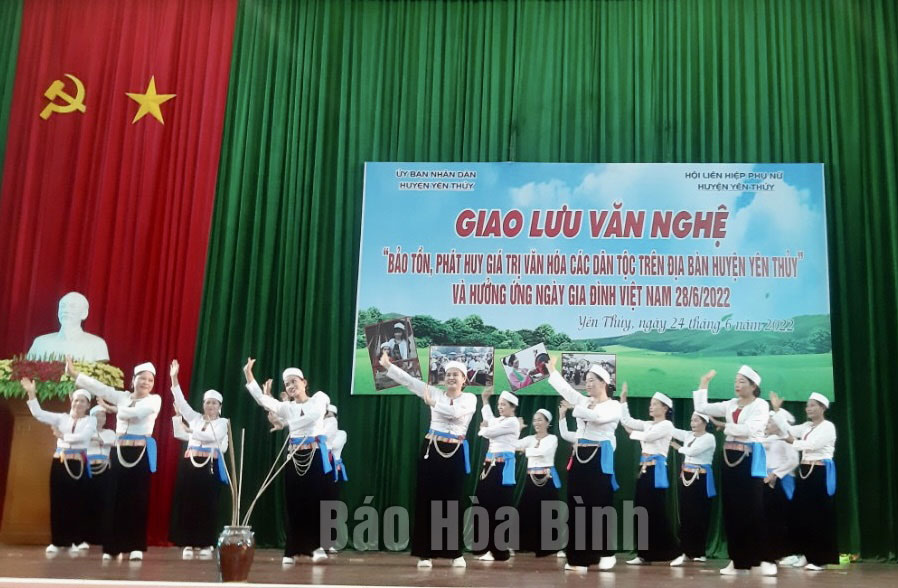
(HBO) – Yen Thuy district in the northern mountainous province of Hoa Binh is home to 61,000 people, belonging to seven different ethnic groups. The Muong ethnic group accounts for 69.22 percent, while the Kinh group accounts for 30 percent. Each group has its own unique cultural identity, creating a diverse and rich culture.

Women clubs in Yen Thuy district conduct
art performance exchanges to preserve, promote cultural values of ethnic
groups.
According to Tran Trung Kien, Head of
Culture-Information Division of Yen Thuy district, the community has a high
sense of conservation and promotion of the nation’s fine traditional cultural
values. They are joining hands to preserve traditional values of their ethnic
group and the culture in general.
Over the years, the work of preserving and
promoting the cultural identities of ethnic groups in the area has been
identified by the district as an important task, contributing to the education,
dissemination and effective implementation of the Party's guidelines, State’s policies
and laws.
The district Party Committee has led and
directed all levels and branches to educate and thoroughly grasp the guidelines
and policies on the work of preserving and promoting cultural heritage.
It also strengthens communication and promotion
so that people of all walks of life understand the guidelines and policies on
ethnic affairs, the importance and position of preserving and promoting the
values of ethnic heritages.
The Party Committee of Yen Thuy district also
focuses on restoring, preserving and promoting community cultural activities
and folk games. They honor artisans, families and communities by recognizing
their achievements in preserving and promoting the values of ethnic cultural
heritage.
The district is home to 12 recognised relics and
scenic spots, including three national-level recognized sites.
Since 2018, the district has restored a number
of relic sites, such as the Hang pagoda, the Thuong temple (in Yen Tri commune),
and the Phu Ve temple (Doan Ket commune). The provincial People’s Committee
approved a project to restore and improve Tac Duc pagoda in Lac Thinh commune
on March 15, 2022.
In preserving intangible cultural heritage, the
district has strengthened its promotion and honours its artisans. Gong clubs
have been established in Lac Sy commune, Huu Loi commune, and Cheo singing
clubs have been established in Ngoc Luong commune, as well as Mo Muong Clubs in
Yen Thuy district. Two artisans have been recognized as excellent artisans in
intangible cultural heritage
In addition, the conservation of cultural heritage is associated with promoting
local tourism strengths.
In the district, there are many spiritual
tourist destinations that attract tourists far and wide. They are the Hang
pagoda (Yen Tri commune), the Tac Duc pagoda (Lac Thinh commune), and the Xam
communal house (Phu Lai commune).
The conservation and promotion of these cultural
heritage sites has positively impacted many areas of social life. It contributes
to improving the cultural and spiritual lives of local people, consolidates
unity, while assisting to successfully carry out political, socio-economic
tasks in the locality./.
With an increasingly vibrant and widespread emulation movement aimed at building cultured residential areas and cultured families, Yen Thuy District has been making steady progress toward improving both the material and spiritual well-being of its people, while fostering a civilized, prosperous, beautiful, and progressive community.
Once lacking recreational spaces and community facilities, Residential Group 2 in Quynh Lam Ward (Hoa Binh City) has recently received attention for the construction of a new, spacious, and fully equipped cultural house. The project followed the model of state support combined with public contributions in both labor and funding.
The "All people unite to build cultural life" movement, which has been effectively integrated with Kim Boi district’s socio-economic development goals, is fostering a lively spirit of emulation across local residential areas, hamlets, villages, public agencies, and enterprises. In addition, through the initiative, traditional cultural values are being preserved and promoted, while community solidarity and mutual support in poverty reduction and economic development are being strengthened.
A working delegation of the Hoa Binh provincial People’s Committee led by its Permanent Vice Chairman Nguyen Van Toan on June 11 inspected the progress of a project to build the Mo Muong Cultural Heritage Conservation Space linked to tourism services in Hop Phong commune, Cao Phong district.
Born and growing in the heroic land of Muong Dong, Dinh Thi Kieu Dung, a resident in Bo town of Kim Boi district, in her childhood was nurtured by the sweet lullabies of her grandmother and mother. These melodies deeply imprinted on her soul, becoming an inseparable part of her love for her ethnic group's culture. For over 20 years, this love for her hometown has driven Dung to research, collect, and pass down the cultural values of the Muong people to future generations.
In the final days of May, the Ethnic Art Troupe of Hoa Binh Province organized performances to serve the people in remote, mountainous, and particularly disadvantaged areas within the province. These were not just ordinary artistic shows, but they were the meaningful journeys aimed at spreading cultural values, enhancing the spiritual life of the people and contributing to the preservation of ethnic minority cultural identities.



